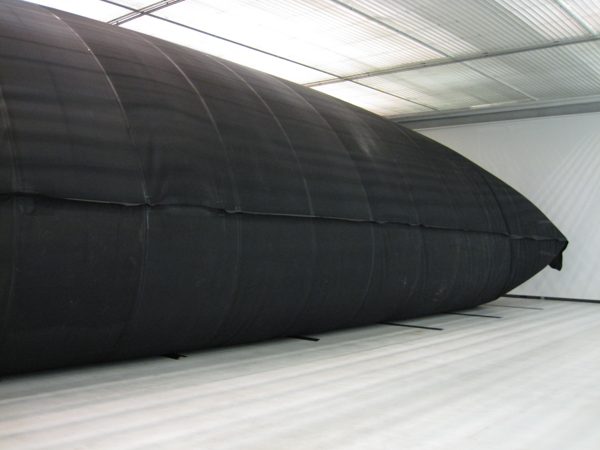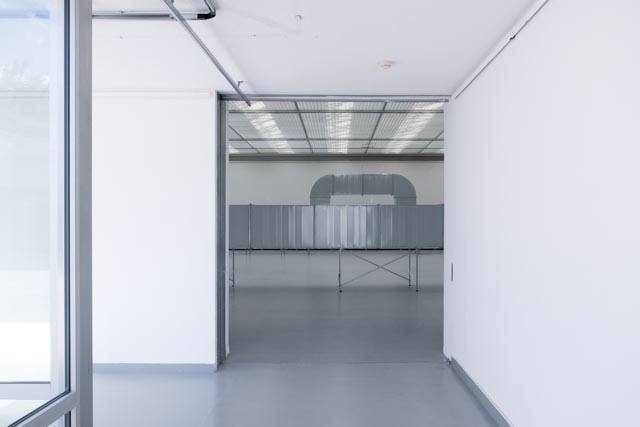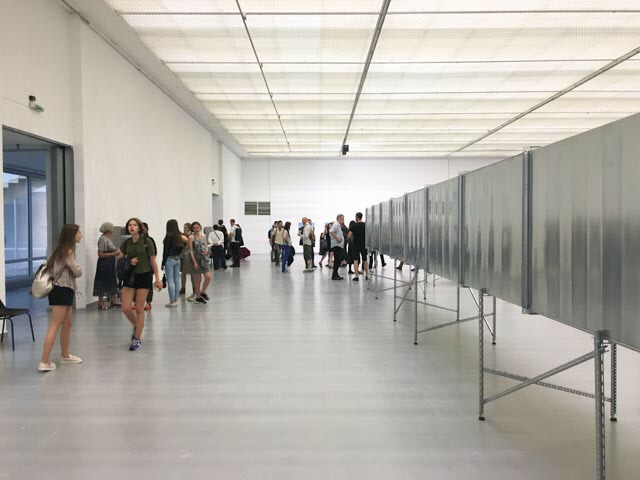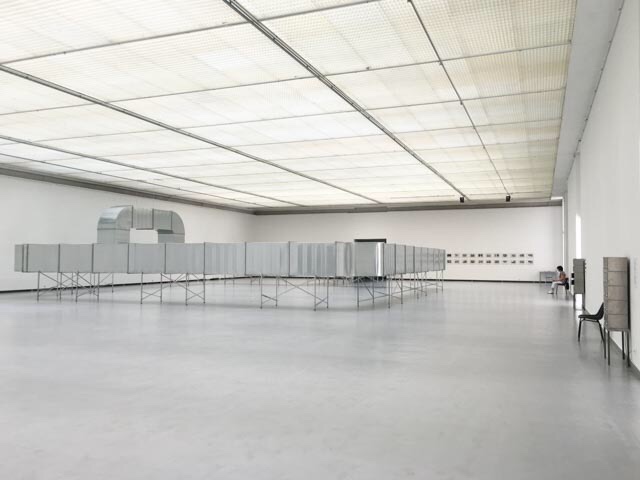This weekend marks the thirtieth anniversary of the fall of the Berlin Wall and, to commemorate, I thought it would be appropriate to post this chapter from Blue Monday, which Robert Sumrell and I published a decade ago as AUDC.
My Dear Berlin Wall
On June 17, 1979, Eija-Riita Eklöf, a Swedish woman, married the Berlin Wall at Groß-Ziethener Straße, taking Wall Winther Berliner-Mauer as her name. The final piece of heroic modernist architecture, the Berlin Wall was constructed just as the movement’s Utopian political ambitions had begun to wane. By then, with the eastward spread of modernism during the Khrushchev years, the ideological distinctiveness of modernity had come to an end, making East-West, modern–antimodern harder to distinguish. Still, the architects of the Berlin Wall hoped it would change society.
For a while, it did just that. After the close of World War II, Berlin was a microcosm of Germany. Both city and country were cut into four occupation zones, each overseen by a commander-in-chief from one of the four Allied powers, the United States, the United Kingdom, France, and the Union of Soviet Socialist Republics. As the geopolitical tide continued to shift in the years after the war, tensions escalated between the Soviets and the Western allies. By the time of the Berlin Blockade of 1948-1949, it became clear that the three allied segments of Berlin would become “West Berlin,” an enclave of the Federal Republic of Germany (or “West Germany”) while the Soviet-controlled sector would become “East Berlin,” associated with the German Democratic Republic (or “East Germany”). Responding to the blockade crisis, Belgium, Canada, Denmark, France, Iceland, Italy, Luxembourg, Netherlands, Norway, Portugal, United Kingdom, and the United States promised mutual military defense through the North Atlantic Treaty Organization (NATO) in 1949. In 1955, West Germany joined NATO and, in response, the Soviet Union formed the Warsaw Pact with Albania, Bulgaria, Czechoslovakia, Hungary, Poland, and Romania. East Germany joined one year later as two events cemented the division of the world. The first was the Suez Crisis in which the United States, fearing thermonuclear war with the Soviet Union, forced France and Britain to withdraw from the Suez Canal, a critical piece of infrastructure they had occupied earlier that year to prevent Egypt from nationalizing it. The second was the Hungarian Revolution, crushed by Soviet tanks as the West watched. With the refusal of the Soviet Union and the United States to enter into direct confrontation, it became clear that the world, Europe, Germany, and Berlin had been divided into spheres of influence controlled by the superpowers.
The superpowers fought the Cold War through their display of achievements in science, propaganda, and accumulation. Berlin became the prime place for the two competing rivals to showcase their material culture. In the East, the Stalinallée, designed by architects Hartmann, Henselmann, Hopp, Leucht, Paulick and Souradny, was a nearly 2km long, 89m wide boulevard, lined with eight-story Socialist Classicist buildings. Inside these vast structures, workers enjoyed luxurious apartments, shops, and restaurants. In response, West Berlin held the Interbau exhibit in 1957, assembling the masters of modern architecture including Alvar Aalto, Walter Gropius, Le Corbusier, Oscar Niemeyer, Johannes van den Broek and Jaap Bakema, Egon Eiermann, and Pierre Vago to build a model modernist community of housing blocks in a park in the Hansaviertel quarter.
Nor was the battle of lifestyle between East and West limited to architecture. Soviet communism followed capitalism to focus on industrial productivity and expansion within a newly global market. While the United States exported its products—and eventually outsourced its production—throughout the world, the Soviets used COMECON, the economic equivalent of the Warsaw Pact, to eliminate trade barriers among communist countries. Each country produced objects to represent its superior quality of life, validating each system not only to its own citizens, but also to each other and to the rest of the world. The importance of material culture in the Cold War is underscored by the 1959 Nixon-Khrushchev “Kitchen Debate,” played out between the two powers in a demonstration kitchen at a model house during the American National Exhibit in Moscow. At the impromptu debate, Soviet Premier Nikita Khrushchev expressed his disgust at the heavily automated kitchen and asked if there was a machine that “puts food into the mouth and pushes it down.” U. S. Vice President Richard Nixon responded, “Would it not be better to compete in the relative merits of washing machines than in the strength of rockets? ” A Cold War battle was fought through house wares.(1)
The climax of the battle came in Berlin. In the divided city, half a million people would go back and forth each day between East and West. Westerners would shop in East Berlin where products, subsidized by the East Bloc, were cheap. Easterners would shop in the Western sector where fetish items such as seamless nylons and tropical fruits could be found. Overall, however, the flow was westward. The rate of defection was unstoppable: between 1949 and 1961 some 2.5 million East Germaners left for the West, primarily through Berlin. But just as destructive was the mass flight of subsidized objects westward, a migration that pushed the inefficient communist system to collapse. Khrushchev had won the debate: cheap goods from the East were more desirable, but the cost to the system was unacceptable. By this time, production and accumulation in the East Bloc had became goals in and of themselves, devoid of logic and use, no longer tied to the basic needs of the economy. In 1961, Khrushchev launched the Third Economic Program to increase the Soviet Union’s production of industrial goods at all costs. During a meeting that year, COMECON decided that the flow of people and products had to be stopped. On August 13, 1961 the border was sealed with a barrier constructed by East German troops.
The result was a city divided in two without regard for prior form or use. Over time, the Berlin Wall evolved from barbed wire fences (1961-1965) to a concrete wall (1965-1975), until it reached its full maturity in 1975. The final form would be not one but two Walls, each constructed from 45,000 3.6 meter high by 1.5 meter wide sections of reinforced concrete, each weighing 2.75 tons, separated by a no-man’s-land as wide as 91 meters. The Wall was capped by a smooth pipe, making it difficult to scale and was accompanied by fences, trenches, and barbed wire as well as over 300 watchtowers and thirty bunkers. (2)
With its Utopian aspiration to change society, the Wall was the last product of heroic modernism. It succeeded in changing society, but as with most modernist products, not in the way its builders intended. East Berlin, open to the larger body of the East Bloc, withered, becoming little more than a vacation wonderland for the Politburo élite of the Soviet Union and Warsaw Pact and a playground for spies of both camps. Cut off, West Berlin thrived. By providing a datum line for Berlin, the Wall gave meaning to the lives of its inhabitants. In recognition of this, Joseph Beuys proposed that the Wall should be made taller by 5cm for “aesthetic purposes.” (3)
As the Wall was being constructed in Berlin, Situationists in Paris and elsewhere were advocating for radical changes in cities as a means of preserving urban life. For them, the aesthetics of modernism and the forces of modernity were destroying urbanity itself. During this period working-class Paris was being emptied out, its inhabitants sent by the government to an artificial modernist city in the suburbs while an equally artificial cultural capital for tourists and industry was created in the cleaned-up center. Led by Guy Debord, the Situationists hoped to recapture the city by creating varied ambiances and environments and strategies providing opportunities for stimulation and chance drift. When Situationist architect Constant Nieuwenhuys deployed the floating
transparent layers of his New Babylon to augment the existing city with unique, flexible and transient spaces Debord condemned the project, arguing that the existing city was already almost perfect. Only minor modifications, were necessary, such as adding light switches to street lights so that they could be turned on and off at will and allowing people to wander in subways after they were shut off at night.
In his 1972 thesis at the Architectural Association, entitled “Exodus, or the Voluntary Prisoners of Architecture,” Rem Koolhaas found a way of reconciling modernism with Situationism through the figure of the Wall. Suggesting that the Wall might be exported to London and made to encircle it, Koolhaas writes, “The inhabitants of this architecture, those strong enough to love it, would become its Voluntary Prisoners, ecstatic in the freedom of their architectural confines.” Inside, life would be “a continuous state of ornamental frenzy and decorative delirium, an overdose of symbols.” Although officially proposing a way of making London more interesting, Koolhaas’s thesis is really a set of observations about the already existing condition of the real Wall. (4)
In choosing to encircle London with the Wall, Koolhaas recognized that it was not only the last great product of modernism, it was the last work of heavy architecture. Already in 1966, in his introduction to 40 Under 40, Robert Stern observed that an increasingly dematerialized “cardboard architecture” was “the order of the day” in the United States while in England, architects such as Archigram were proposing barrier-less technological utopias.(5)
Built of concrete, the wall was solid, weighty. It hearkened back to the days of the medieval city walls, which were not only defensive but attempted to organize and contain a world progressively more interconnected through communications and trade. Walls acted as concentrators, defining places in which early capitalism and urbanity could be found and intensifying both. So long as the modes of communication remained physical and the methods of making and trading goods were slow, nations retained their authority and autonomy through architectural solidity.
The destruction of the Berlin Wall in 1989 is concurrent with the pervasive and irreversible spread of Empire and the end of heavy architecture. Effectively, the Wall fell by accident. During 1989, mass demonstrations in East Germany led to the resignation of East German leader Erich Honecker. Soon, border restrictions between neighboring nations were lifted and the new government decided to allow East Berliners to apply for visas to visit West Germany. On November 9, 1989, East German Minister of Propaganda Günter Schabowski accidentally unleashed the Wall’s destruction. Shortly before a televised press conference, the Minister was handed a note outlining new travel regulations between East and West Berlin. Having recently returned from vacation, Schabowski did not have a good grasp on the enormity of the demonstrations in East Berlin or on the policy being outlined in the note. He decided to read the note aloud at the end of his speech, including a section stating that free travel would be allowed across the border. Not knowing how to properly answer questions as to when these new regulations would come into effect, he simply responded, “As far as I know effective immediately, right now.” Tens of thousands of people crowded the checkpoints at the Wall and demanded entry, overwhelming border guards. Unwilling to massacre the crowds, the guards yielded, effectively ending the Wall’s power. (6)
The Schabowski mis-speak points to the underlying reason for the Wall’s collapse: the lack of information flow in the East Bloc. The goals of Khrushchev’s Third Economic Program were finally met by the early 1980s, but by that point the United States was no longer interested in production. For America, the manufacturing of objects proved to be more lucrative when outsourced to the developing world. By sending its production overseas, America assured the success of its ideology in the global sphere while concentrating on the production of the virtual. Having spent itself on production of objects, as well as on more bluntly applied foreign aid, the Soviet Union collapsed. Manuel Castells observes that, “in the 1980s the Soviet Union produced substantially more than the US in a number of heavy industrial sectors: it produced 80 percent more steel, 78 percent more cement, 42 percent more oil, 55 percent more fertilizer, twice as much pig iron, and five times as many tractors.” The problem, he concludes, was that material culture no longer mattered. The PC revolution was completely counter to the Soviet Union’s centralization while photocopy machines were in the hands of the KGB. (7)
With the Wall gone, and with it the division between East and West undone, the world is permeated by flows of information. Physical borders no longer hold back the flow of an immaterial capital. Indeed, soon after the Wall fell, the European Union set about in earnest to do away with borders between individual nation states.
But through it all, the Wall has had no greater fan than Wall Winther Berliner-Mauer. In her view, the Wall allowed peace to be maintained between East and West. As soldiers looked over the Wall to the other side, they saw men just like themselves, with families they loved and wanted to protect. In this way, the Wall created a bond between men who would otherwise be faceless enemies. But Berliner-Mauer’s love for the Wall is far from abstract. For her, objects aren’t inert but rather can possess souls and become individuals to fall in love with. Berliner-Mauer sees the Wall as a noble being and says she is erotically attracted to his horizontal lines and sheer presence. While Berliner-Mauer is in a seemingly extreme, sexual relationship with the object of her desire, our animistic belief in objects is widespread across society. Adults and children alike confide in stuffed animals, yell at traffic signs, and stroke their sports cars all the time. Many people choose to love objects over their friends, their spouses, or themselves. Berliner-Mauer understands that the role of objects in our lives has changed. Objects are no longer tools that stand in to do work for us, or surrogates for normal human activities. Objects have come into their own, and as such we have formed new kinds of relationships with them that do not have a precedent in human interaction. The Wall is a loving presence in her life, and she loves it in return.
Faced with the tragedy of the Wall’s destruction, Berliner-Mauer created a technique she calls “Temporal Displacement” to fix her mind permanently in the period during which the Wall existed, even at the cost of creating new memories. (8) For Berliner-Mauer, marrying the Wall is a last means to preserve the clarity of modernism and the effectiveness of architecture as a solid and heavy means of organization. To love the Berlin Wall is to dream of holding onto the simple, clear disciplinary regime of order and punishment that came before we were all complicit within the system. In today’s society of control, as Gilles Deleuze writes, we don’t need enclosures any more. Instead, we live in a world of endless modulations, internalizing control in order to direct ourselves instead of being directed.(9) After the fall of the Wall and the end of enclosures, even evil itself, Jean Baudrillard observes, loses its identity and spreads evenly through culture. An Other space is gone from the world. North Korea and Cuba are mere leftovers, relegated to tourism. There is nowhere to defect to: without the Wall, we must all face our own complicity in the system.(10)
(1) Elaine Tyler May, Homeward Bound: American Families in the Cold War Era (New York: Basic Books, 1999), 10-12.
(2) Thomas Flemming, The Berlin Wall: Division of a City (Berlin: be.bra Verlag, 2000), 75.
(3) Irving Sandler, Art of the Postmodern Era (Boulder, Colorado: Westview Press, 1998), 110.
(4) Rem Koolhaas, S, M, L, XL (New York: Monacelli, 1995), 2-21.
(5) Robert A.M. Stern, ed., 40 Under 40: An Exhibition of Young Talent in Architecture (New York: The Architectural League of New York, 1966), vii.
(6) Angela Stent, Russia and Germany Reborn: Unification, the Soviet Collapse, and the New Europe (Princeton: Princeton University Press, 1999), 94-96.
(7) Manuel Castells, End of Millennium, Second Edition (Oxford, UK: Blackwell, 2000), 26-27, See also the entire chapter on “The Crisis of Industrial Statism and the Collapse of the Soviet Union,” 5-67.
(8) https://www.berlinermauer.se (note from 2019: Eija-Riitta Eklöf-Berliner-Mauer died in 2015 and this site is now some kind of spam site)
(9) Gilles Deleuze, “Postscript on the Societies of Control,” October, Vol. 59 (Winter 1992), 3-7.
(10) Jean Baudrillard, “The Thawing of the East,” The Illusion of the End (Stanford, Stanford University Press, 1994), 28-33.





